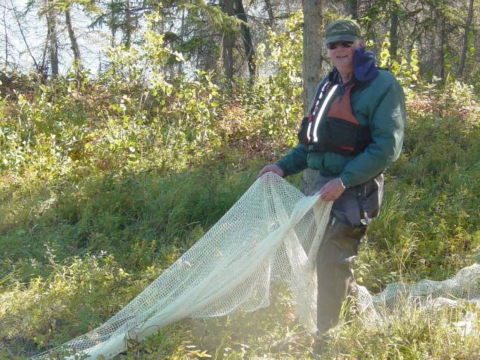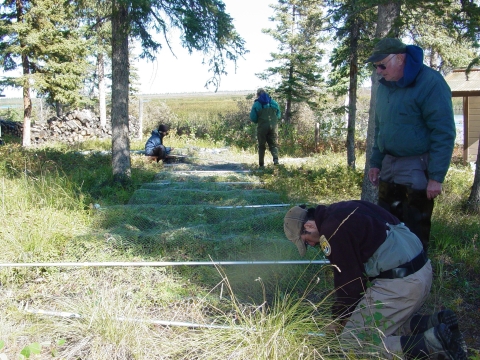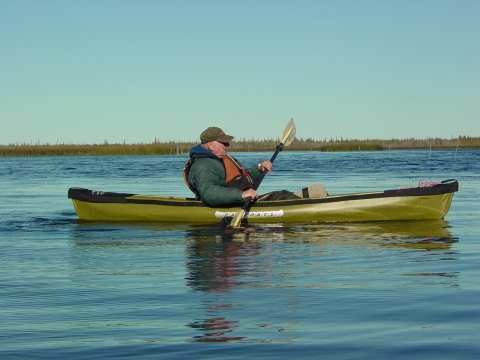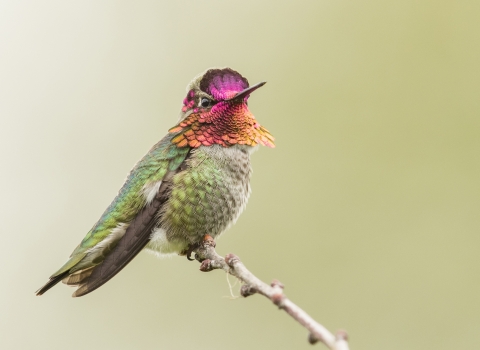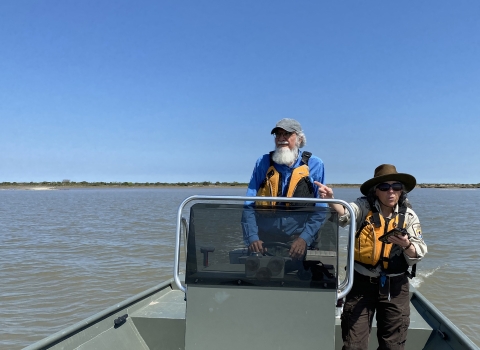James Gore “Jim” King, a Service conservation hero, recently passed away in Juneau at age 96. Jim leaves behind a legacy with the Service that includes a significant role in establishment of national wildlife refuges in Alaska. Mr. King was born in Portland, Maine, in 1927 and came to Alaska in 1949. He learned to fly single engine airplanes on wheels, skis, and floats in the Fairbanks area and initially served as a game warden during hunting and trapping seasons and spent his summers helping with waterfowl surveys and banding. He then accepted a job as the first manager of Clarence Rhode National Wildlife Refuge, which later became part of Yukon Delta National Wildlife Refuge. Two years later, a job opened in the Service’s Waterfowl Division, and he and Mary Lou (his wife) and children moved to Juneau where his biggest work responsibility was the annual migratory waterfowl breeding pair survey of Alaska. He flew thousands of miles at 100 feet above the ground to inventory waterfowl breeding areas, eventually training his successor Bruce Conant. Together, their work helped to define Alaska’s most productive wetlands. Mr. King’s early success in waterfowl banding landed him in charge of Alaska’s largest duck banding project –which ultimately led to the establishment of seven national wildlife refuges.
His work also helped save Yukon Flats. Shortly after Alaska statehood, newly elected Senator Gruening hatched a plan to dam the Yukon River at Rampart to stimulate the Alaska economy. This dam would have created a reservoir the size of Lake Erie and displaced residents of the Yukon Flats whose homes and ancestral lands would be flooded. The Service was tasked with learning about the area’s waterfowl resources. Mr. King, other biologists, and local residents banded over 20,000 ducks in two years, mostly at Ohtig Lake south of Chalkyitsik, Alaska. Mr. King was very proud of this operation, in part, because he involved local residents, including Clifford Adams of Fort Yukon. Ducks banded on the Yukon Flats went to at least 45 states, eight provinces, and even to South America. Displacement of the local residents and duck band return information generated quite a bit of public opposition to the dam, including opposition from members of Congress. In the end the Rampart Dam project was scrapped because of opposition from virtually every state game department in the country.
A product of his time when Indigenous People's sovereignty was ignored, Mr. King suggested to Gordon Watson (then the Service’s Alaska supervisor) building on the momentum the project created and proposing the area as a national wildlife refuge national wildlife refuge
A national wildlife refuge is typically a contiguous area of land and water managed by the U.S. Fish and Wildlife Service for the conservation and, where appropriate, restoration of fish, wildlife and plant resources and their habitats for the benefit of present and future generations of Americans.
Learn more about national wildlife refuge . Watson thought that was a good idea, and Mr. King’s work had put Yukon Flats on the map as an important waterfowl production area waterfowl production area
Waterfowl production areas are small natural wetlands and grasslands within the National Wildlife Refuge System that provide breeding, resting and nesting habitat for millions of waterfowl, shorebirds, grassland birds and other wildlife. Virtually all waterfowl production areas are in the Prairie Pothole Region states of Iowa, Minnesota, Montana, North Dakota and South Dakota.
Learn more about waterfowl production area . With the passage of the 1971 Alaska Native Claims Settlement Act, Congress directed the Secretary of the Interior to recommend public lands for conservation in Alaska. Armed with years of scientific information, Mr. King and another Service biologist (Calvin Lensink) were called to Washington DC and given the chance of a lifetime – to suggest which areas of Alaska needed permanent protection for breeding waterfowl. Ultimately, Mr. King’s work combined with the shared vision of Native and conservation leaders, resulted in the creation of seven national wildlife refuges in Alaska –including Yukon Flats National Wildlife Refuge.
Taking a stand for Indigenous People was nothing new for Mr. King. In spring 1960, he learned of discussions about the Service beginning to enforce the Migratory Bird Treaty Act in Alaska. At the time he was still a game management agent in Fairbanks. He decided to write a memo to the regional director stating, "A rigid enforcement program does not seem justified among Natives [People] who are traditionally dependent on waterfowl." In the memo he outlined his knowledge of Alaska Native People and their customary and traditional use of migratory birds, stating, “It was brought out at the recent meeting that the BSF&W [the Service] has a moral as well as a legal obligation with regard to the use of waterfowl by Native [People] in the more remote parts of Alaska. The problem then is to work out a policy that is fair to the native [person] without being subject to undue criticism from local white residents, outside politicians and conservationists and other federal agencies … Native [People] do not like evasive answers from game wardens any more than game wardens like evasive answers from Washington brass … there may be a culture barrier between the white [person] and native [person] but there is no intelligence barrier … It would seem that a ‘Let’s all get together and save the duck,’ approach to the problem would be far more acceptable to all concerned than a ‘Don’t break the Law or else’ approach.”
Mr. King flew for 30 years with the Service, logging 6,555 hours as pilot in command and retired in 1983, but retirement was just an administrative action. He remained highly engaged in conservation activities for decades and logged 3,000 hours as a co-pilot, observer and mentor with the Service (as a reemployed annuitant) and with private companies doing bird work. Jim served on the Citizens Oil Spill Advisory Committee that was formed after the Exxon Valdez oil spill in Prince William Sound, served as President of the Trumpeter Swan Society, helped establish the Bald Eagle Research Institute in Juneau and wrote successful petitions to list the Steller’s Eider and Spectacled Eider for protection under the Endangered Species Act. Jim and his wife Mary Lou received the Chevron Conservation Award in 1989 for their long-standing conservation work in Alaska. Jim was awarded the Distinguished Service Award in 2002 by the U.S Fish and Wildlife Service, the highest Departmental honor award that can be granted to a career employee. Besides being a trailblazer in conservation, Jim was an exceptional person and was known for being kind, encouraging and an inspiration to all including college students whom he mentored. His legacy is an important part of Alaskan history that continues to inspire today’s conservation leaders and upcoming generations invested in Alaska’s future.

